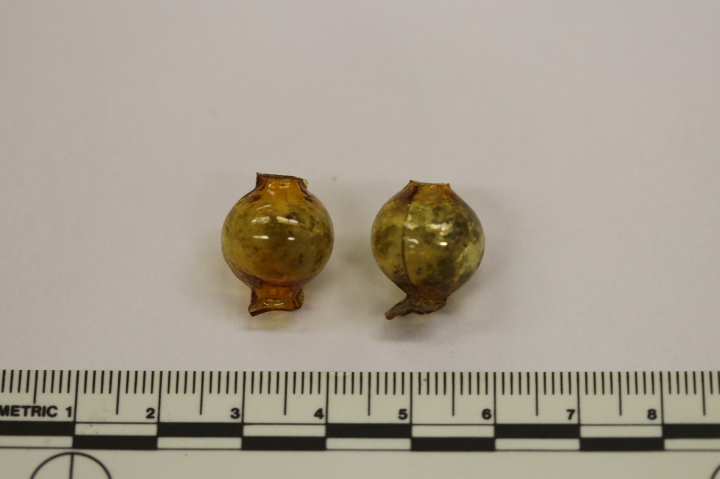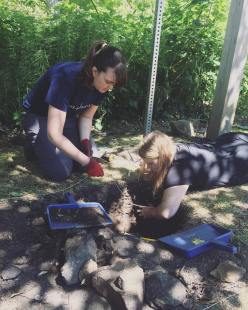
Pic: the medium sized beads of clear glass with an indeterminate interior colour
Recently my field season in BC came and went by in a blur of time. It was a busy, but rewarding season on the Sunshine Coast, working with the shíshálh Nation and the shíshálh Archaeological Research Project. Our time was again spent excavating Snake Bay (which will be featured in a fantastic television show’s upcoming second season). We also spent a significant amount of time in the shíshálh’s Tems Swiya museum helping prepare their new exhibit on the facial reconstructions of four of their ancestors, known as the Ancient Chiefs (check these out for more information: Forbes, National Geographic). Stay tuned to our project blog in the next few months for more information about this year’s field season!
Part of my time on the Sunshine Coast this summer was spent collecting a bit more data about the Sexwamin glass beads for my thesis (check out Part 1 for details on what I’ve been researching and what I know so far). I had two main goals this summer. The first was to spend some time in the museum taking better photographs and recounting all of the beads. The sign installation had been completed a year after I had started the project and I knew that some more beads had been collected, but I had no idea how many. I wanted to get the total counts of the beads and try to better subdivide them into individual colour and size categories. My second goal was to put a small excavation unit in the area where the beads had been collected in an attempt to photograph any sort of stratigraphic layers present. And most importantly, I also had a chance to present my research to the shíshálh Rights and Title office. I’m working with shíshálh history and it’s important to keep them involved and updated in every way! I shared with them what I had found out about the glass beads and how uncovering them added to what is known about the site from where they were found. Happily they all found my research interesting and important to know!
Without futher ado, here are some exciting updates on the glass beads from Sexwamin:
Numbers
The first thing I did in the museum was recount all of the glass beads. I knew that my colleague had found some more when he finished the sign installation project, but I hadn’t had the chance to find out numbers prior to my CAA presentation. During my short excavation this season I also found some more. If you’ll remember from my first post about my research, we had collected 80 intact beads and 34 fragments from the original excavation for the sign post in 2015, which was the largest quantity of these beads from the 5 North American sites where they’ve been found. I’m excited to say that from excavations between 2015 and 2017 that number has grown. By a lot. Take a look at the charts below:

Another way of looking at the colour breakdowns,



In addition, I also got some great photo examples illustrating why I’ve argued that the beads were blown in a chain and broken down into individual beads. As shown by these two extra large beads, you can see fragments of the neighbouring chain beads which weren’t broken away cleanly! As an added bonus they also show a great example of the seams that run along the sides of the beads.

Excavations
When I originally excavated the glass beads in 2015, there was no easily visible stratigraphy in the unit, which I argued went to show how disturbed that area was. This summer I marked out a 1m x 1m unit but only excavated the NE quad, which was closest

to the original unit. The plan was that depending on what was found I would open up the rest of the unit. Luckily we found nothing that warranted opening up the entire unit. I say lucky because there were so. many. rocks. Excavation was slow and a bit difficult, but we persevered. And in the end the stratigraphy was there enough to support my idea that the lack of stratigraphy in the original unit was due to disturbance in that immediate area. It also supported my claim of bottoming out at 40 cm because we again bottomed out at 40 cm. And, though I wasn’t looking for the original burial location, the fact that we didn’t encounter the burial gives us a better idea of where it might actually be. So really, no information is useful information.

So there you have it! Some updates on my glass bead research. When I first encountered these beads in 2015 I had no idea they were so unique and special. Or that I would come to learn as much about glass beads as I’ve learned so far. That I would end up researching glass beads at all. But isn’t that the point of research? To learn something we didn’t know before?
Support Research and Outreach:

2 thoughts on “Part 2: Updates on the Little Glass Time Machines – Sexwamin and the Bohemian Blown-Glass Beads”